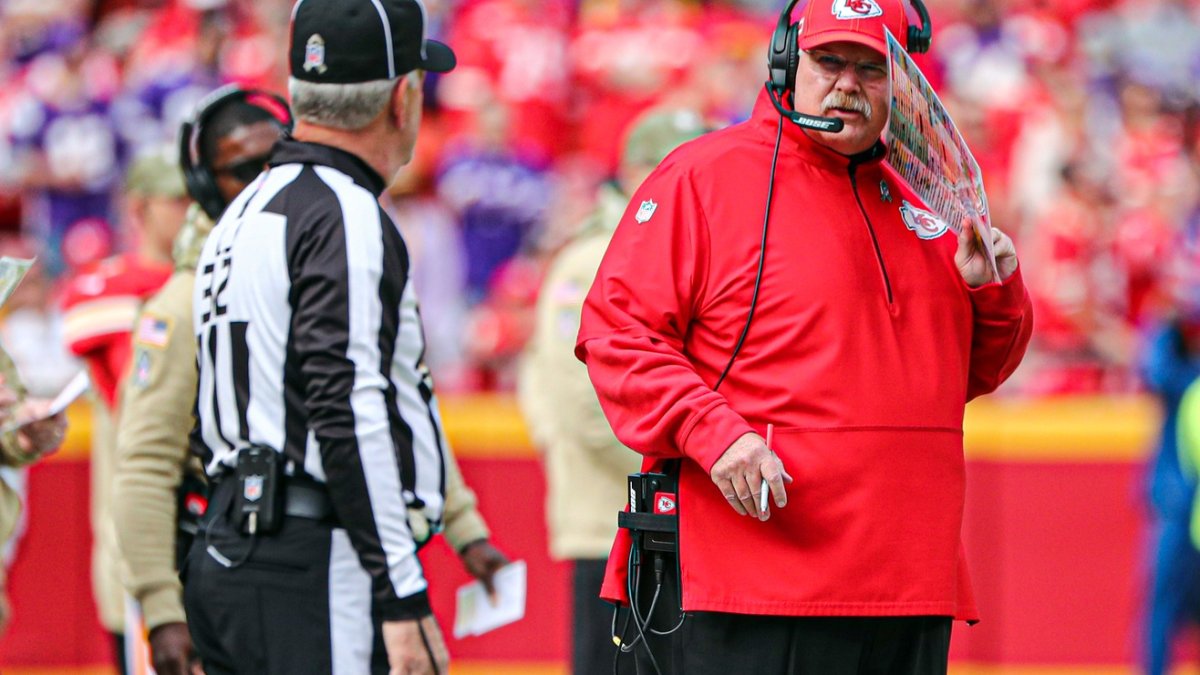In a season that has been riddled with quarterback injuries, win-challenged teams and a lack of homefield advantage that took until Week 9 to regress, the importance of coaching has never been more apparent than it is now.
Here at PFF, we grade every player on every play of every game, and while we do not explicitly grade play-callers, we can use these grades to figure out which teams are performing higher than expected on a play-for-play basis using the machine learning capabilities of AWS. Using expected points added and its derivative, success rate, we present the three offensive play-callers that are punching well above their weight class through the season’s first nine weeks.
Andy Reid, Kansas City Chiefs
Reid has made this article before, and while his time management is a significant concern, he’s nothing short of brilliant during the other 14/15ths of the game. He’s gotten to show this off over the last two weeks, where journeyman backup Matt Moore generated over 10 yards per pass attempt on his 26 play-action passes, posting over a 130 passer rating. Moore was asked to use play-action more than all but one passer during that stretch, leading the Chiefs to 25 points per game in the 2018 NFL MVP’s stead. The Patrick Mahomes injury has not been an isolated one offensively, either, with Tyreek Hill, Eric Fisher and Sammy Watkins all missing multiple games to start the year.
Overcoming personnel issues is not Reid’s only good trait, though. For example, no team passes the ball more during their team’s first 15 plays than Reid, and as a consequence, few are as efficient during the early portion of games. It’s how the Chiefs, despite having mostly a weak defense the last two-plus seasons, have won a larger percentage of games decided by more than one score than every team in the league sans New England.
Sean Payton, New Orleans Saints
Sean Payton went 5-0 starting his backup quarterback, and that is really all you need to know about how good he is at pushing the right buttons on offense. Teddy Bridgewater was by no means bad ranking 18th in raw PFF grade per snap, but he certainly isn’t the MVP candidate New Orleans is used to. During the Bridgewater era, Payton kept the Saints' offense in gear with artful play-calling that asked his quarterback to simply do what was expected of any NFL quarterback. On screen passes, Teddy had a league-high 135.6 passer rating, and he also led the league in passer rating on throws that earned an expected PFF throw grade. During that five-game winning streak, the Saints ranked fifth in expected points added per early-down pass play (how much does each play get you closer to or further away from scoring), and each team ahead of them had a quarterback with a top-10 PFF grade.
With Brees now back in the saddle, don’t expect any of Payton’s brilliance to go in vain. Brees will add the ability to make to top-tier throws that Teddy couldn’t and elevate the offense to a level that makes the Saints the best team in the NFC, if not the NFL.
Greg Roman, Baltimore Ravens
We saw the Lamar Jackson offense on display during Sunday Night Football, and Greg Roman deserves a lot of credit for this offense’s effectiveness. In terms of creativity and uniqueness, it’s difficult to find an offense as varied as Baltimore’s, and this allows them to have success despite a relatively high designed run rate. Against New England Sunday night, the Ravens ran the ball on 40 of 67 offensive plays but picked up 124 rushing yards before contact against the league’s highest-ranked defense. If all of the negative things said about Jackson were actually true, one could argue that these yards are a substitute for poor passing on early downs…
Luckily for the Ravens, Jackson is far better than what the naysayers thought. One of our biggest concerns going into the season was his fumbling and inaccuracy, and he’s improved mightily in these areas. Jackson is currently in the middle of the pack in our adjusted completion percentage (74.5), one spot ahead of Mahomes, which is more than enough accuracy to complement what he can do with his legs. One of the reasons he’s been so effective is the number of targets he’s allocating to tight ends (44%, highest in the NFL), which we’ve shown to be the most-efficient targets in the NFL, and another feather in the cap for Roman as one of the league’s greatest offensive minds.



 © 2025 PFF - all rights reserved.
© 2025 PFF - all rights reserved.